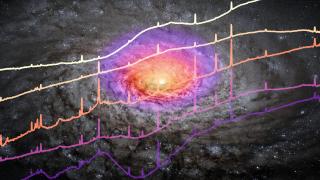Bibcode
Mori, T. I.; Imanishi, Masatoshi; Alonso-Herrero, Almudena; Packham, Chris; Ramos Almeida, C.; Nikutta, Robert; González-Martín, O.; Perlman, Eric; Saito, Yuriko; Levenson, Nancy A.
Bibliographical reference
Publications of the Astronomical Society of Japan, Volume 66, Issue 5, id.9310 pp.
Advertised on:
10
2014
Citations
12
Refereed citations
12
Description
We report near-infrared K ', L', and M ' band imaging observations of
the nearby merging galaxy NGC 6240 with the Infrared Camera and
Spectrograph on the Subaru telescope. The observations were performed
with the assistance of the Subaru Adaptive Optics System, and the
achieved spatial resolutions were around
0{^''.}10-0{^''.}20. We also obtained new
mid-infrared imaging in the Si-2 filter band (8.7 μm) and N-band
(7.5-13 μm) spectroscopy of this galaxy with the CanariCam on the
Gran Telescopio Canarias with a spatial resolution of
0{^''.}4-0{^''.}5. In the K ' band image the two
nuclei of the galaxy each show a double peak suggesting the complex
geometry of the source, while the L', M ', and Si-2 band images show
single compact structures in each of the two nuclei. Assuming that the
center core observed at wavelengths longer than 3.8 μm is associated
with dust heated by the buried AGN, we re-evaluated the spectral energy
distributions (SEDs) of the southern nucleus from 2 to 30 μm with
additional literature values, and performed the SED+spectroscopy fit
using the clumpy torus models of Nenkova et al. (2008a, ApJ, 685, 145;
2008b, ApJ, 685, 160) and a Bayesian fitting approach. The model fit
suggests that the high covering factor torus emission in the southern
nucleus is also obscured by foreground dust in the host galaxy. The
estimated AGN bolometric luminosity of the southern nucleus,
Lbol(AGN) ˜ 1 × 1045 erg
s-1, accounts for approximately 40% of the whole luminosity
of the system.
Related projects

Nuclear Activity in Galaxies: a 3D Perspective from the Nucleus to the Outskirts
This project consists of two main research lines. First, the study of quasar-driven outflows in luminous and nearby obscured active galactic nuclei (AGN) and the impact that they have on their massive host galaxies (AGN feedback). To do so, we have been granted time with the Gran Telescopio CANARIAS (GTC) in the optical and near-infrared ranges
Cristina
Ramos Almeida